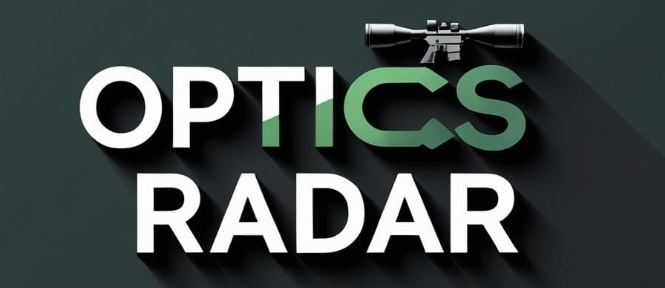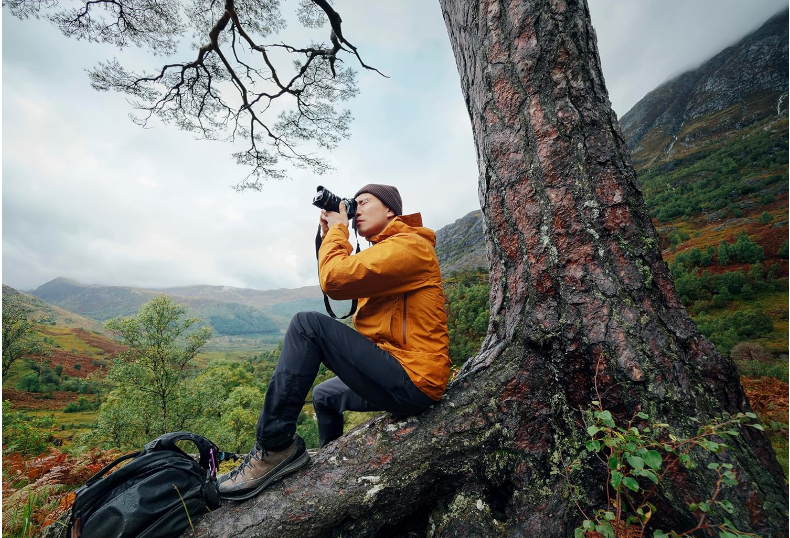Are you searching the best camera for wildlife photography? If yes, allow our in-depth guide to introduce you to the best cameras that combine superb optics, fast autofocus, high-resolution sensors, continuous shooting, and durability.
Thanks to advancements in camera tech, it’s become a lot easier for photographers to capture wildlife in all sorts of environments. We’re talking about amazingly light designs, AI-powered tracking, and incredibly low-light capabilities, after all.
It’s like having a whole new toolkit at your disposal, making it possible to be both accurate and creative out there!
Which is better, DSLR or mirrorless Camera for Wildlife Photography?
You know, mirrorless camera technology really is something else, especially for capturing wildlife. It’s amazing how these cameras can help you get those stunning shots of animals in their natural habitat.
They have a ton of incredible technology, such as AI focusing, which is ideal for keeping up with those swift animals. And let me tell, if you want to catch those quick moments, these guys can shoot at an impressive burst speed of 30 to 40 frames per second.
Then there’s the whole back-illuminated or stacked sensor thing, which really boosts performance in low light. It also enhances dynamic range and resolution. So, if you need to crop your photos, you can do it without losing that precious detail.
Let’s not forget how light and compact they are! That’s a game-changer for those long hikes. DSLRs do offer advantages, such as durability and long battery life, but mirrorless cameras frequently outperform DSLRs due to their quick autofocus and strong video capabilities.
Let’s get started with the top cameras right away.
Best Camera for Wildlife Photography
1.Nikon Z 8 | Professional full-frame mirrorless stills/video hybrid camera | Nikon USA Model
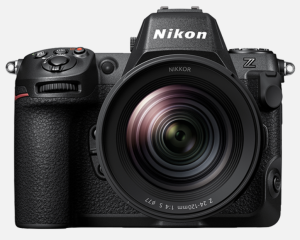
This camera is really something special — a full-frame mirrorless option that perfectly balances speed, image quality, and reliability. If you’re into wildlife photography in 2025, this could be one of your top picks.
What’s amazing is that it’s designed as a hybrid camera for both stills and video. You get this impressive 45.7MP stacked CMOS sensor, paired up with Nikon’s EXPEED 7 processing engine. It has amazing resolution and performance, whether you’re capturing speedy animals or those gorgeous landscapes. Its weather-sealed body further adds to its durable construction.
Not to be overlooked is the autofocus system. It can detect focus in pretty low light — down to -9 EV. That means it can track moving animals with ease, whether you’re trying to snap a bird in flight or catch a glimpse of a sneaky cat. The autofocus is spot on and gives you that confidence you need when shooting.
This camera can recognize all sorts of subjects. Think people, pets, vehicles — you name it. Whether you’re into wildlife, sports, or even portraits, the Z 8 has got you covered.
The Z 8 truly shines when it comes to speed. There are many options available to wildlife photographers, including 20 fps, 30 fps, 60 fps, and even an incredible 120 fps for continuous photography. That way, you can capture every fleeting moment, whether it’s a bird launching into the air in an instant or a predator stealthily stalking its prey.
Plus, it has all these flexible still image formats like RAW 14-bit, High Efficiency RAW, 10-bit HEIF, and JPEG 8-bit. So, you get top-notch detail without hogging all your storage.
Now, if you’re into video too, this camera is pretty much a beast. It can shoot internal 8K/60p and 4K/120p, which is fantastic for anyone serious about wildlife filmmaking. And it’s got support for 12-bit N-RAW and ProRes RAW. Talk about cinematic quality!
Plus, there are some cool creative features like Skin Softening, Portrait Impression Balance, and Improved White Balance. These little extras make it super versatile, so you can nail those stunning portraits just as easily.
Pros
- 7MP stacked CMOS sensor with outstanding image quality and dynamic range.
- Advanced EXPEED 7 processor for fast performance.
- Cutting-edge autofocus with deep learning, -9 EV low-light detection, and 3D tracking.
- Blazing fast burst rates: 20, 30, 60, and 120 fps.
- Robust and weather-sealed build for outdoor durability.
- 8K/60p and 4K/120p internal video with 12-bit N-RAW and ProRes RAW options.
- Flexible still formats: RAW, HEIF, and JPEG.
- Excellent color science and portrait features for versatility.
Cons
- Larger and heavier compared to some mirrorless competitors.
- High price point may not suit all budgets.
2.Canon EOS R5 Mark II
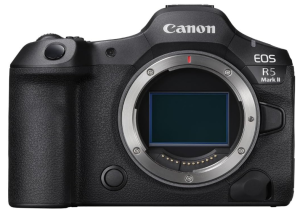
The Canon EOS R5 Mark II really shines as the best camera for wildlife photography. It’s built for both passionate hobbyists and seasoned pros who want top-notch image quality, the ability to crop way in on their shots, and autofocus that just works like a charm.
This camera packs a powerful punch with its 45MP full-frame back-illuminated stacked CMOS sensor. It manages low light like an expert and produces stunning image quality.. Whether you’re trying to capture the intricate details of a bird’s feathers or a quick moment of wildlife in action, the R5 Mark II gives you all the clarity you need for those professional-level shots.
Furthermore, its autofocus system got a serious upgrade. Now, there’s this eye control focus that lets you choose your subject just by looking at it through the viewfinder. It makes shooting feel almost effortless.
Plus, if your subject ducks behind something for a second, no worries! The R5 Mark II keeps its focus locked on, so you won’t miss any of those exciting moments.
The R5 Mark II really shines when it comes to high-speed action, boasting continuous shooting speeds of up to 30 frames per second with its electronic shutter. Perfect for capturing those fleeting moments, like birds soaring through the air or animals racing about.
The Action Priority mode, which cleverly leverages scene data to determine the primary subject and locks the focus on it, is awesome. This makes it super reliable, especially in those unpredictable wildlife situations where anything could happen.
The R5 Mark II isn’t just about still photos; it’s a hybrid marvel. It is capable of uninterruptedly shooting stills and video simultaneously. For wildlife photographers who also experiment with documentaries, this is revolutionary. You can quickly transition between taking photos and recording videos while making sure you don’t miss any important moments.
Pros
- 45MP back-illuminated stacked CMOS sensor with outstanding image quality and cropping flexibility.
- Fast 30 fps electronic shutter for capturing high-speed action.
- Advanced autofocus with eye control focus and subject tracking, even when obscured.
- Action Priority mode intelligently predicts and locks onto the main subject.
- Ability to capture stills and video simultaneously without interruptions.
- Excellent build quality and ergonomics suited for professional use.
Cons
- High-resolution files can require significant storage and processing power.
- Premium price point may be out of reach for casual users.
3.Sony Alpha 1 II Full-Frame Mirrorless Interchangeable Lens Camera
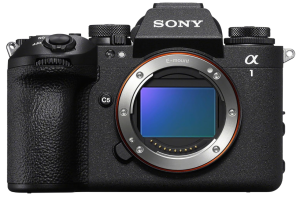
If you enjoy taking wildlife photos, the Sony Alpha 1 II is a fantastic full-frame mirrorless camera that will revolutionize your game. It all comes down to speed, accuracy, and resolution. With its impressive 50.1MP Exmor RS image sensor and the super-efficient BIONZ XR image processing engine, you get images that are not just high-resolution but also bursting with detail and color. Even when you’re shooting in APS-C mode, you still get a solid 21MP resolution.
Now, let’s talk about what really sets this camera apart: handling fast action. I mean, it can shoot continuously at a whopping 30 frames per second! Plus, you get that blackout-free viewing, which means you can track those unpredictable wildlife moments as if you’re actually there in real time.
The camera also does 120 AF/AE calculations every second. It ensures that every shot you take is spot on, perfectly exposed and in focus. For wildlife photographers who are after the best in speed, resolution, and smart autofocus, the Alpha 1 II is just ideal. It’s definitely built for the pros!
The Alpha 1 II comes packed with this super advanced AI processing unit that really boosts its Real-time Recognition AF and Real-time Tracking capabilities. It’s pretty impressive, it can recognize and keep track of all sorts of subjects, from animals and birds to insects, vehicles, and even people.
For wildlife photographers, this autofocus system is a game changer, especially when you’re trying to capture those fast-moving creatures or deal with tricky tracking situations. You definitely want to keep that focus sharp!
Moreover, this camera isn’t just great for still shots; it’s a real powerhouse for video work too. It can handle 8K 4:2:2 10-bit XAVC HS recording, and get this—it can oversample from 8.6K, giving you some seriously stunning video quality. So, if you’re a wildlife filmmaker, you can crop and edit 4K footage from those 8K sources, which means you get that cinematic detail and flexibility that’s just amazing.
Plus, it supports various formats like XAVC HS, S, and S-I, with speeds going up to 600 Mbps. The Alpha 1 II really shines both as a professional video tool and a stills camera.
Pros
- 1MP full-frame Exmor RS sensor with exceptional resolution and dynamic range.
- Up to 30 fps blackout-free shooting with full AF/AE tracking.
- Advanced AI autofocus system for accurate recognition of people, animals, birds, and insects.
- 120 AF/AE calculations per second for flawless exposure and focus during fast action.
- APS-C crop mode delivers 21MP images for added versatility in wildlife photography.
- 8K video recording with oversampling from 8.6K and robust 4K options.
- Works seamlessly with Sony’s G Master lens lineup for professional-grade optics.
Cons
- Premium price point, suitable mainly for professional photographers.
- Large file sizes from 50.1MP sensor require high-capacity storage and fast cards.
4.OM SYSTEM Olympus OM-1 Mark II Micro Four Thirds System Camera
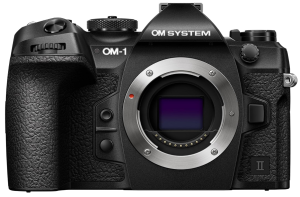
The OM SYSTEM Olympus OM-1 Mark II is a pretty nifty Micro Four Thirds camera, especially if you’re someone who loves to travel light but still wants great performance. It’s really perfect for bird watchers and nature enthusiasts.
It strikes a nice balance between being professional enough for serious shots while still being compact enough to take on long hikes or tough outdoor conditions. At its heart, you’ll find a 20MP stacked BSI Live MOS sensor. This thing really shines when it comes to resolution, color quality, and keeping noise levels low, even when lighting gets tricky.
The OM-1 Mark II runs on the TruePic X processing engine, which is actually up to three times quicker than the older models. That means everything is faster, from rendering images to responding when you’re snapping high-speed bursts.
Plus, it’s got this Cross Quad Pixel AF system with 1,053 all cross-type focus points. It means you get full coverage for precise focusing, making it a breeze to catch fast-moving wildlife or birds in flight. So, you can lock in on those moments with confidence!
One of the really cool things about the OM-1 Mark II is its awesome computational photography features. We’re talking about tools like Handheld High-Resolution Shot, Focus Stacking, Live ND, and HDR shooting. These really let photographers create stunning images that usually need fancy gear or a ton of post-processing.
Let’s not forget about how durable this camera is. It has IP53 weather sealing, which means it is dustproof, splashproof, and can withstand cold temperatures as low as -10°C. So, whether you’re hiking in the rain, battling dust, or braving the cold, the OM-1 Mark II can handle it everything.
Pros
- Lightweight and portable Micro Four Thirds system, perfect for wildlife and travel.
- 20MP stacked BSI Live MOS sensor with excellent resolution and low noise.
- TruePic X engine offers up to 3x faster processing for seamless performance.
- Cross Quad Pixel AF with 1,053 all cross-type points for precise autofocus.
- Computational photography modes like Handheld High-Res, Live ND, and HDR shooting.
- Exceptional weather sealing (IP53) , dustproof, splashproof, and freeze-proof to -10°C.
- Great for bird and nature photography, especially when paired with long MFT lenses.
Cons
- Micro Four Thirds sensor offers less dynamic range compared to full-frame options.
- 20MP resolution may be limiting for heavy cropping needs.
5.Fujifilm X-H2S Mirrorless Camera Body
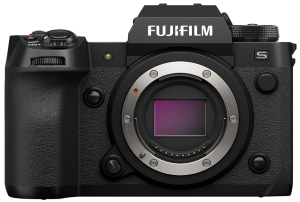
The Fujifilm X-H2S is seriously one of the most adaptable APS-C mirrorless cameras you can find out there. If you’re into wildlife photography, this camera really stands out. It delivers high-speed performance, advanced autofocus, and top-notch color science, all without breaking the bank like some full-frame cameras do.
At its core, you’ve got a 26.1-megapixel X-Trans 5 stacked back-illuminated sensor. It uses Fujifilm’s special X-Trans color filter array, which helps reduce moiré and those pesky false colors. In return, you receive outstanding photographs with bright colors, excellent low-light performance, and up to 14 stops of dynamic range. Perfect for those unpredictable lighting situations you often find in nature!
The X-Processor 5 is three times faster than what you had with the X-T4, which means you can expect incredible performance for both photos and videos. For wildlife enthusiasts, this translates into continuous shooting speeds of 15 frames per second with the mechanical shutter.
If you switch to the electronic shutter, you’re looking at a jaw-dropping 40 fps! Plus, there’s a deep buffer that lets you shoot unlimited JPEG and RAW images on high-speed cards.
And don’t forget about the in-body image stabilization! Even when using telephoto lenses, it provides up to seven stops of shaking reduction, allowing you to get those crisp handheld photos.
The autofocus system on this camera is super-fast and smart, working even in really low light, like down to -7EV. It’s got this AI-driven Subject Detection feature that can track all sorts of subjects, whether it’s birds, animals, horses, or things like cars, planes, and trains. The Enhanced Face and Eye Detection can keep an eye on people wearing glasses or face coverings, so you don’t have to worry about missing that perfect wildlife or action shot.
Now, if you’re into video, the X-H2S really stands out. It offers some serious capabilities, think 6.2K at 30P, 4K at 120P, and Full HD at 240P. You can even record 10-bit 4:2:2 Apple ProRes footage right onto CFexpress Type B cards.
And if you want to go external, it supports ProRes RAW and Blackmagic RAW through the Type A HDMI port. Plus, the fact that it can shoot for up to 90 minutes on a single battery, that’s a game changer for anyone working on wildlife documentaries or just long shooting days.
Pros
- 1MP stacked X-Trans 5 BSI sensor with outstanding color reproduction and dynamic range.
- High-speed performance: up to 40 fps (electronic shutter) and 15 fps (mechanical).
- AI-driven Subject Detection AF for accurate tracking of birds, animals, and vehicles.
- In-body image stabilization (IBIS) with up to 7 stops of compensation.
- Advanced video features:2K/30P, 4K/120P, Full HD/240P, and internal 10-bit 4:2:2 ProRes.
- Lightweight APS-C design that’s travel-friendly yet professional-grade.
- Excellent color science, ideal for nature and wildlife shots.
- Deep buffer for extended continuous shooting sessions.
Cons
- APS-C sensor offers less resolution and depth of field compared to high-megapixel full-frame cameras.
- Requires CFexpress Type B cards for maximum performance, which can be expensive.
Read Also:
Tips on Choosing the Best Camera for Wildlife Photography
When choosing the best camera for wildlife photography you should consider the following factors:
- Autofocus Performance and Tracking
If you enjoy wildlife photography, a quick and efficient autofocus mechanism is essential. You are aware of the unpredictable nature of animals, right? They dart around, sometimes with lightning speed. So, when looking for a camera, look for one with excellent subject identification and tracking. It should be able to track everything from large animals to small, fast-moving ones.
Real-time eye detection and AI tracking are powerful features that can make a significant difference. And don’t forget about the autofocus coverage area; having a broad range is quite useful. It ensures that you get sharp, clear photos even when the subject is partially obscured or acting erratically.
- Speed and Continuous Shooting
When it comes to capturing that perfect wildlife shot, it really helps to snap off a bunch of frames in quick succession. I mean, think about it—when a bird suddenly takes off or a predator is on the prowl, you want to be ready! That’s where a camera with fast burst shooting speeds comes into play. Whether it’s using mechanical shutters or electronic ones, you definitely don’t want to miss those fleeting moments.
And here’s another thing: having a big buffer capacity is super important. It allows you to continue shooting for an extended period of time without the camera slowing down. In certain high-stakes scenarios, believe me, that may make all the difference. So, if you’re serious about wildlife photography, you need invest in equipment that can withstand short bursts!
- Sensor Quality and Image Resolution
A high-resolution sensor is essential for capturing all of the fine features of wildlife. I mean, especially one that can handle a wide dynamic range and performs well in low light.
And when you’re trying to snap shots of animals that are far away—where your lens just can’t quite reach—having those extra megapixels is a game changer. It lets you crop your photos down without losing any clarity, which is pretty crucial, right?
Furthermore, a good sensor should be able to control noise at higher ISO settings so that you can get crisp, detailed photos even in dimly lit or early morning conditions.
- Durability and Weather Sealing
Photographing wildlife can truly challenge you. You’re out there in a variety of environments, such as humid rainforests, dusty plains, or even freezing cold! You really need a solid camera if you want to take great photos, especially when the weather gets rough. I mean, you want something that can handle all sorts of conditions, right? Good weather sealing is a must.
With features like being water-resistant, dust-proof, and even freeze-proof, you can really just focus on getting that perfect shot. No one wants to be stressed out about their gear failing them when they’re trying to capture those unforgettable moments.
Best Camera for Wildlife Photography FAQS
- Is it better to travel with DSLR or mirrorless?
When it comes to travel photography, a mirrorless camera is often the way to go. They are more compact and lighter, to start. Because of this, they are quite easy to bring on lengthy hikes, particularly while attempting to take photos of animals.
Additionally, these cameras include a ton of amazing technology. Imagine having a little powerhouse in your purse with high burst speeds and fast AI-powered autofocus. What about the performance of the sensor? Simply excellent. So, if you’re looking to capture some great shots without the bulk, mirrorless is definitely worth considering.
- What is the main benefit with a mirrorless camera?
Mirrorless cameras are pretty amazing when it comes to tech and how well they perform, particularly for wildlife photography. I mean, can you believe they can shoot at these wild burst rates—like 30 to 40 frames per second? That’s pretty impressive!
And then there’s the autofocus—it’s super quick and really accurate. It definitely helps when you’re trying to catch those quick, elusive moments. So, if you’re into photography, especially of animals, these cameras are definitely worth considering!
And then there are the sensors. We’re talking about stacked or back-illuminated designs that really boost dynamic range and resolution, not to mention they work wonders in low-light conditions. It’s like they know exactly what you need.
Also, let’s not forget about the weight. They’re smaller and lighter, which is a big deal if you’re hiking for hours. No one wants to lug around a heavy camera, right? And with those cool hybrid stills and video features, they really set themselves apart from your regular DSLRs.
Conclusion
When it comes to picking the best camera for wildlife photography, you really need to think about a few key things: speed, image quality, and how reliable it is when you’re out there in the wild.
You know, those advanced systems with super-fast autofocus and quick burst rates? They’re a game changer. They help ensure you don’t miss those oh-so-important moments, even when the weather isn’t cooperating.
Whether you’re a pro making a living behind the lens or just someone who loves to wander and capture the world, today’s cameras can really help you showcase the stunning beauty of wildlife like never before. Seriously, you might just be amazed at what you can capture out there!
